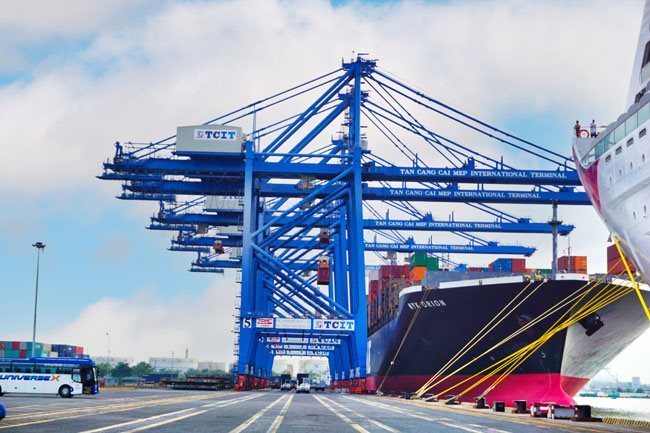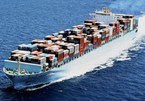
Although it was freed on March 29, 2021, the consequences are dire. The blockage of the canal has been cleared now. What are its implications for Vietnam?
The Suez Canal was blocked for days, so many ships were stuck, causing delays in delivery and disrupting the global supply chain, which was already in trouble.
Impacts on Vietnam
With a capacity of over 20,000TEU and a length of 400m, the Ever Given is one of the world’s biggest container ships and was fully loaded when it was lodged. The impacts of the incident extended far beyond the goods it contained.
Although the route passing through the Suez Canal is the shortest to link Asia and Europe, the incident has affected not only trade between Asia and Europe but also that between Asia and Northern America. The Cosco Shipping
Peony, a 13,500-TEU container ship that transports cargo from North America to Vietnam, planned to enter Cai Mep - Thi Vai Port (CM - TV) on April 6 but was stuck in the Suez Canal and had to shift the expected arrival date to April 12. As of March 29, almost 180 other ships shared the same fate with the Cosco Shipping Peony and had to wait to enter the Indian Ocean. Some of them are also bound for Vietnam.
Exports from Vietnam to both Europe and North America have been hampered, too. The Arnold Maersk, an 8,000-TEU container ship, had to head towards the Cape of Good Hope to avoid the Suez Canal. The route was more than 6,000km longer and cost US$400,000 more and the delivery period was extended by at least a week.
The time taken for containers to wait for the obstruction to be cleared and then to pass through the canal not only breeds delays but also triggers unintended consequences. After the Suez Canal has been cleared, major ports in Europe and Asia may be under strains since many ships enter them within a short period. Feeder ships must also wait for mother ships at transshipment ports, so smaller ports in Asia will be in trouble, too. In April 2021, ports in Vietnam may face this problem.
Besides, container ships from Europe and North America to Asia not only carry cargo but also have empty containers, so that they can be loaded with export products. The severe shortage of empty containers in Asian countries, including Vietnam, will be worsened by the incident.
An undesirable consequence is that shipping charges may soar and other fees will rise, too.
Many maritime experts say that as of April 5, shipping charges for main routes such as Asia - Europe and Asia - North America were yet to rise, but those for routes linking Asia to South Africa, Western Africa and South America climbed up. Given Vietnam’s export profile, this will not leave significant impacts yet.
Other implications
There are other implications that Vietnam’s authorities and enterprises should pay attention to.
First, the incident pertains to giant container ships. The Ever Given is among the world’s biggest, and while controversy still simmers over their benefits and drawbacks, over 600 container ships of more than 10,000TEU are in operation and almost 200 are being built. When these ships meet with accidents along routes of strategic international importance, the impacts will be severe, with the incident in the Suez Canal as a case in point.
Since Vietnam operated deepwater container ports at CM - TV (2009) and Lach Huyen (2018), these giant container ships have entered the country at a greater frequency and incidents, while less serious than that in the Suez Canal, have arisen.
In May 2011, the container ship Grete Maersk ran aground at CM - TV and took three days to rescue. In June 2018, the container ship ZIM New York was also stuck at CM - TV and took one day to free. In June 2019, the Nagoya Express got into an accident after leaving Lach Huyen port.
Collision with the cranes (US$5 million) caused the latter to be out of order and the export of Vietnamese goods to be delayed. While there were no serious chain effects, a question remains—what will happen if container ships of 14,000-18,000TEU, far greater than the 5,000-9,000TEU capacity of the above container ships, run aground?
There has been feedback from port and shipping firms that CM - TV and Lach Huyen routes do not meet design standards, but solutions (which involve dredging) have not been efficiently implemented.
Consequently, ships docking at CM - TV and Lach Huyen are not only loaded below their capacity but also confronted with risks. This issue was brought up when former Prime Minister Nguyen Xuan Phuc, now State President, visited Ba Ria - Vung Tau on March 20. It is hoped that the Suez Canal fiasco will compel related agencies to promptly address this problem to minimize risks in Vietnam’s shipping industry.
The supply chains of Vietnamese firms will be hampered to some extent by the Suez Canal incident. Materials may arrive late and some export orders may not be fulfilled as scheduled. While such an incident is unexpected, similar ones may occur, spelling trouble for supply chains.
Fragile supply chains have plagued many firms since Covid-19 spread. Many enterprises have pondered how to adjust their production models. Just-in-time models, which rely on accurate forecasting and reliable transport services, are gradually replaced by just-in-case models, under which firms must maintain inventories in case delivery incidents arise. Soren Skou, CEO of A.P. Moller-Maersk, one of the leading and most renowned container lines, has also suggested enterprises embrace this shift.
SGT

Goods owners say shipping freight costs are far too high
The high container shipping cost has caused difficulties for import/export companies. They believe that shipping firms joined hands to push service fees up.